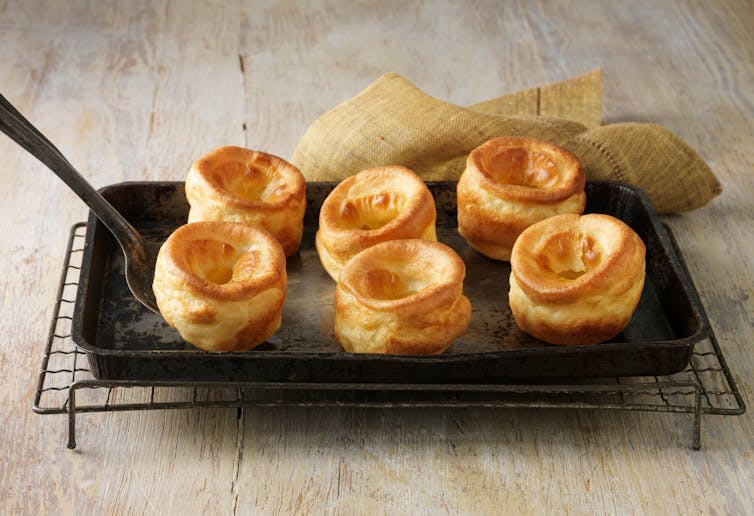
Christmas dinner is considered by many to be the best meal of the year and yet when it comes to deciding what this meal should consist of people’s opinions often differ.
For some there will never be a centre piece that can replace the turkey, although often there are additional meats included such as roast ham, beef or pork, alongside roast potatoes, Brussels sprouts, pigs in blankets, bread sauce and stuffing. And of course, there are those who are vegetarian or vegan and prefer a nut roast.
Then there’s the Yorkshire pudding. For some a must-have on Christmas day while for other more traditionalists it seems a Yorkshire pudding should go nowhere near a Christmas dinner.
To understand the origins of the Yorkshire pudding Christmas dinner debate we need to turn the clock back to the time when the original pudding was first created.
The origin story
Prior to being given the prefix of Yorkshire in 1747 in the bestselling cookbook The Art of Cookery Made Plain and Simple by English cookery writer Hannah Glasse, a Yorkshire Pudding was simply known as a “batter” or “dripping pudding”.
The original serving of the Yorkshire pudding was as an appetiser to a main meal, usually with gravy. This was because it would fill you up, meaning you wouldn’t eat as much meat, which was expensive. It was originally cooked in northern England over a fire with the meat roasting above it. The fats and juices from the meat would drip into the pudding and provide flavour and colour.
Traditionally, the word “pudding” referred to homely and rustic desserts that were commonly eaten by the lower classes. These could be either sweet or salty. Pudding dishes are mainly made with flour and have a cake-like consistency. Other savoury puddings include – steak and kidney pudding and suet pudding.

The Yorkshire Pudding is a baked pudding made from a batter of eggs, flour and milk or water. It has become a common British side dish which is versatile and can be served in many different ways – although mainly recognised as an accompaniment to a roast dinner. Yorkshire puddings were originally made by tipping the batter into the fat around the roasting meat, but progressed over the years to be given their own square dish.
The smaller circular puddings we are more familiar with today date back to Hannah Glasse’s original recipe, in which spoonfuls of batter were dropped into fat surrounding the meat – and often referred to as Yorkshire puffs.
It has been suggested the pudding was given the name “Yorkshire” due to the region’s association with coal and the high temperatures this produced that helped to make crispy batter.
Healthy or pure indulgence?
When you look at the individual ingredients that make up a Yorkshire pudding they are quite healthy. But the way they are cooked is another matter.
Eggs, for example, are considered one of the most nutritious foods on the planet and contain protein, vitamin B2, B6, B12, zinc, iron and selenium. Milk is also nutrient rich in both protein and fat along with calcium. While flour can provide you with micronutrients. For example one cup of flour includes one gram of thiamin (vitamin B1), which is 85% of your recommended daily intake.
Traditionally Yorkshire Puddings are cooked in fat or dripping. A small amount of fat is essential in our diets as it’s a source of essential fatty acids, which the body cannot make itself. But too much fat can lead to weight gain.
Vegetable oils such as sunflower can also be used as they reach very high temperatures. There has also been debate as to whether olive oil can be used, however as long as it’s a good quality, true olive oil it’s fine.
Recipes and ideas
As well as being a roast dinner side dish, these humble puddings are ideal for a cheap and filling family supper. The batter can be turned into puffy pizza bases, fluffy wraps and impressive toad in the holes.
It would also appear that Yorkshire pudding style dishes are now eaten all over the world. Japan serves them with anything from cheese to jam and with soup. The popover is the US version of the Yorkshire pudding, which dates back to 1850. While Germany and the Netherlands make Dutch Babies which is a flat Yorkshire pudding with berries and sugar on top.

Back to the original debate then – should we or should we not have a Yorkie with our Christmas Dinner? If you are a strict traditionalist, then technically you should steer clear. It’s unlikely that Yorkshire puddings were included in the first traditional Christmas dinners because they had not yet been invented. Though it should also be noted that neither would one have expected to see pigs in blankets on an early Christmas dinner plate. Despite often being considered a Christmas staple, they’ve only been around since the 1950s.
So I would say, why not include the Yorkshire pudding, food trends are always changing and modernising. Indeed, Christmas dinner dates back to medieval times and has been evolving ever since.
You could even dress these puddings up for the Christmas table – Yorkshire Pudding canapes anyone? While any left over batter could also be used to make a toad in the hole with turkey and gravy – or even topped with cranberries and ice cream – it is Christmas after all.
Hazel Flight does not work for, consult, own shares in or receive funding from any company or organisation that would benefit from this article, and has disclosed no relevant affiliations beyond their academic appointment.
This article was originally published on The Conversation. Read the original article.







